Sarah Sundin's Blog, page 101
March 5, 2023
Today in World War II History—March 5, 1943

Auxiliary carrier USS Bogue (ACV-9) underway near Norfolk, VA, 20 June 1943 (US Navy photo: 80-G-71314)
80 Years Ago—Mar. 5, 1943: RAF sends 442 bombers to Essen, Germany, opening the Battle of the Ruhr—43 major raids through June.
Maiden flight of first RAF jet aircraft, the Gloster Meteor.
In convoy XK-2 off Cape Finisterre, German U-boat U-130 sinks four British freighters with a single salvo of four torpedoes.
Auxiliary carrier USS Bogue begins escort of convoy HX-228 in North Atlantic, the first time Allies assign this class of ship to antisubmarine operations as a primary duty.
The post Today in World War II History—March 5, 1943 first appeared on Sarah Sundin.March 4, 2023
Today in World War II History—March 4, 1943

Movie posters for Mrs. Miniver and Yankee Doodle Dandy (both public domain via Wikipedia)
80 Years Ago—Mar. 4, 1943: Academy Awards emceed by Bob Hope:
Best movie—Mrs. Miniver.Best actor—James Cagney in Yankee Doodle DandyBest actress—Greer Garson in Mrs. MiniverBest director—William Wyler for Mrs. Miniver.US 91st Bombardment Group conducts first trial of armored flak vests.

Waist gunners on a B-24 Liberator wearing protective flak vests and helmets (US National Archives)
The post Today in World War II History—March 4, 1943 first appeared on Sarah Sundin.March 3, 2023
Today in World War II History—March 3, 1943
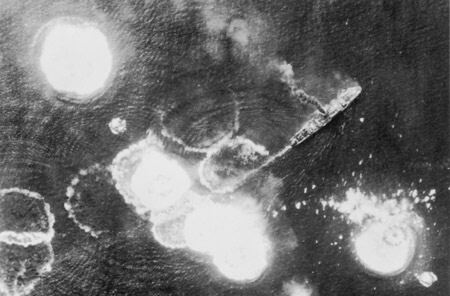
Japanese transport under aerial attack during the Battle of the Bismarck Sea, 3 March 1943 (Australian War Memorial: 128159)
80 Years Ago—Mar. 3, 1943: During Luftwaffe air raid on London, panic causes 173 deaths in Bethnal Green tube station.
In Battle of the Bismarck Sea, Allied aircraft sink Japanese destroyers Asashio, Arashio, Tokitsukaze, and Shirayuki.
The post Today in World War II History—March 3, 1943 first appeared on Sarah Sundin.March 2, 2023
Today in World War II History—March 2, 1943

Bombing of a Japanese ship by B-25 bombers during the Battle of Bismarck Sea, 2-4 Mar 1943 (US Army photo)
80 Years Ago—Mar. 2, 1943: In the Battle of the Bismarck Sea (March 2-5), US Fifth Air Force and Royal Australian Air Force aircraft sink all 8 transports in a Japanese convoy to Lae, New Guinea, and 4 of 8 escorting destroyers; US B-25 Mitchell medium bombers pioneer the use of skip-bombing.
Movie premiere of The Human Comedy, starring Mickey Rooney and Frank Morgan, also Robert Mitchum’s debut.
The post Today in World War II History—March 2, 1943 first appeared on Sarah Sundin.March 1, 2023
The Escape Game by Marilyn Turk
In Leeds, England, in World War II, Beryl Clarke has her hands full with volunteering as an Air Raid Precautions warden, her day job, and her grieving mother. When her pilot brother, James, goes missing in action, Beryl worries whether it might be all too much for her mother. Then she finds out that her company, Waddingtons, is secretly making escape kits for prisoners of war hidden inside Monopoly games.
Kenneth Bordelon, flying with an RAF Eagle Squadron for American pilots, is shot down over German-occupied territory and is taken to a POW camp. Bold and fearless, he escapes twice – but is immediately caught. Soon his friend James Clarke also arrives in the camp. With his broken hand, he’s unable to write home, so Kenneth does the honors – and he’s more than willing, considering the crush he had on James’s sister when he was at Oxford. When Beryl’s letters to James begin making cryptic comments about playing Monopoly, the men are confused – until one of the games arrives in a Red Cross package.
A fascinating read! In The Escape Game, Marilyn Turk shows the human cost of war, from harrowing conditions in England to the bleak life of an Allied prisoner of war in Germany. The true tidbits about the ingenious methods of secretly sending escape kits to those POWs make the story even more interesting. Enjoy!
The post The Escape Game by Marilyn Turk first appeared on Sarah Sundin.Today in World War II History—March 1, 1943
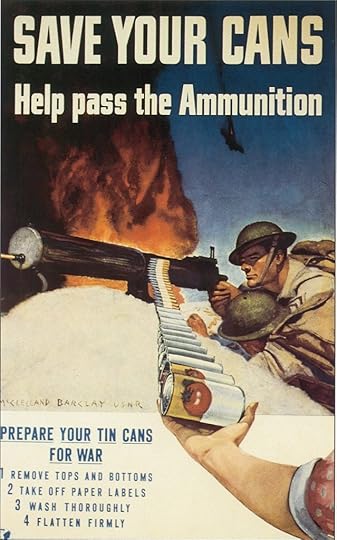
US poster encouraging tin can collection, WWII
80 Years Ago—Mar. 1, 1943: Rosenstrasse Protests begin in Berlin—thousands of Gentile women married to Jewish men protest Nazi detention of their husbands, the only mass protest of the deportation of the Jews in Germany.
Atlantic Convoy Conference meets in Washington, DC, to determine British, Canadian, and US roles in trans-Atlantic shipping.
Maj. Gen. Carl Spaatz takes command of US Twelfth Air Force in Algeria.
War Ration Book Two is issued in the US: canned goods and other processed foods are now rationed at two pounds per week. (Read more: “Make It Do—Rationing of Canned Goods in World War II”)
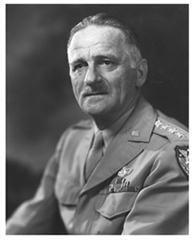
Gen. Carl Spaatz, c. 1947 (US Air Force photo)
The post Today in World War II History—March 1, 1943 first appeared on Sarah Sundin.February 28, 2023
Today in World War II History—February 28, 1943

Norsk Hydro plant in Rjukan, Norway, 1935 (public domain via Norwegian Museum of Cultural History)
80 Years Ago—Feb. 28, 1943: Norsk Hydro Raid: ten Norwegian commandos blow up the German supply of heavy water at Norsk Hydro plant at Rjukan, Norway, delaying German nuclear weapon research.
Construction of Ledo Road crosses the border from India into Burma, with goal of reconnecting with China.
Construction begins on first full-scale plutonium production reactor in the world at Hanford, WA.
The post Today in World War II History—February 28, 1943 first appeared on Sarah Sundin.February 27, 2023
Make It Do – Rationing of Canned Goods in World War II

Rationing of processed foods was an important part of life on the US Home Front. A complex and constantly changing system kept the grocery shopper on her toes.
Why processed foods?Tin was short.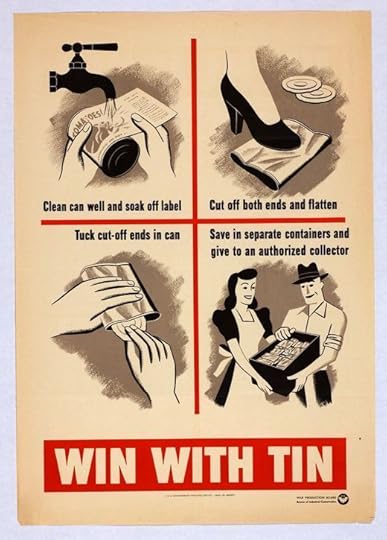
US poster with instructions for tin can collection, 1943
The Japanese controlled 70 percent of the world’s tin supply. Tin’s resistance to temperature, shock, and moisture made it an ideal packaging material. The US military used it for ration tins, ammunition boxes, plasma containers, and for morphine syrettes. The use of tin for civilian purposes had to be curtailed, which meant rationing of canned goods. (See Make It Do – Metal Shortages in World War II)
Food was in high demand.
US Office of War Information poster, WWII
In addition to meeting civilian needs, US farms also fed the military and the Allies. However, an agricultural labor shortage due to the draft and the internment of Japanese-Americans strained the system. Reducing civilian usage of processed fruit and vegetable products through rationing helped reduce the strain.
Which processed foods were rationed?Starting March 1, 1943, three hundred items were rationed, including canned or bottled or frozen fruits and vegetables, canned or bottled juices and soups, and dried fruits. Fresh fruits and vegetables were not rationed, nor were pickles, relishes, or Jell-O.
Points
Safeway ad from the Antioch Ledger (Antioch, CA), 1943, showing ration points for each item
Each rationed item was assigned a point value, which varied over time due to supply, demand, and region. The job of the grocer became more complicated. Products had to be labeled not only with price but with point value. Each month, point values changed, and the grocer had to re-label.
War Ration Book Two
US rationing books owned by my mother and grandmother, WWII (Photo: Sarah Sundin)
On March 1, 1943, War Ration Book Two became active. The blue stamps provided 48 points worth of processed foods each month. This supplied 33 pounds of canned goods per person per year, which was 13 pounds less than prewar usage. Rationing calendars were published in the newspapers to help people keep track of which stamps were current. Stamps were good for eight, five, two, or one points each, with no “change” given, so the shopper had to be careful to use the exact number of points. To prevent fraud, the stamps had to be torn off in the presence of the grocer.
War Ration Books Three and Four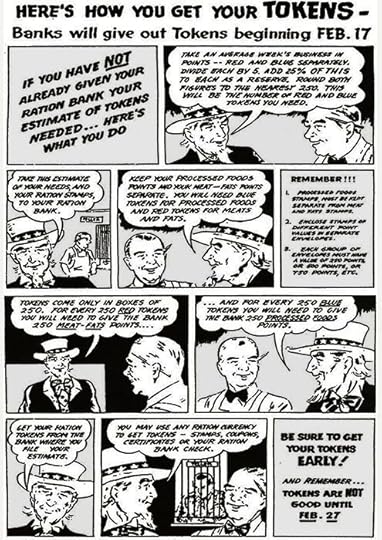
Cartoon giving information on new rationing tokens, February 1944 (US government publication)
Book Three became active in September 1943, but was replaced by Book Four on November 1, 1943. The system was simplified on February 27, 1944, when all stamps became worth ten points, and plastic tokens were issued as change.
Fluctuations
Ration coupon guide from the Antioch Ledger (Antioch, CA), 1 July 1943, showing which coupons were valid that week
Point values changed frequently, and items were often removed from or returned to rationing based on the harvest. On September 17, 1944 after a good harvest—and in preparation for the presidential election—all processed foods except canned fruit were removed from rationing, but were returned to rationing on January 1, 1945 due to the demands of the Battle of the Bulge. After V-J Day on August 15, 1945, processed foods were no longer rationed.
Victory Gardens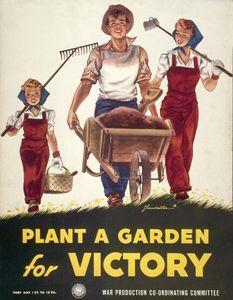
Victory Garden poster, US, WWII
People were encouraged to plant Victory Gardens to reduce the amount of processed foods needed. Newspapers and magazines published how-to articles, and gardens sprang up in backyards, vacant lots, big-city window-boxes, and even on community property. By the end of 1943, Victory Gardens supplied 40 percent of civilian needs for fruits and vegetables.
Canning
US poster encouraging canning, WWII
To put up this bounty, home canning was encouraged. A poll in January 1944 found that 75 percent of housewives canned, and those women canned an average of 165 jars per year. This met the family’s needs and preserved ration points for foods they couldn’t grow. Extra canned fruits and vegetables were often donated to the needy.
How would you like to deal with a system like this?The post Make It Do – Rationing of Canned Goods in World War II first appeared on Sarah Sundin.Today in World War II History—February 27, 1943

US poster, 1943, featuring Norman Rockwell’s “Freedom of Worship”
80 Years Ago—Feb. 27, 1943: Norman Rockwell’s “Freedom of Worship” appears on the cover of the Saturday Evening Post.
Bletchley Park cryptographer Alfred Dillwyn “Dilly” Knox dies of stomach cancer, age 58.
New songs in Top Ten: “For Me and My Gal,” “That Old Black Magic.”
The post Today in World War II History—February 27, 1943 first appeared on Sarah Sundin.February 26, 2023
Today in World War II History—February 26, 1943

Australian troops in the Wau-Mubo area of New Guinea, 29 June 1943 (Australian War Memorial: 015154)
80 Years Ago—Feb. 26, 1943: Six journalists, including Walter Cronkite and Andy Rooney, fly on a US Eighth Air Force bombing raid to Wilhelmshaven, Germany; Robert B. Post of the New York Times is killed in a lost B-24.
Australians secure the area around Wau, New Guinea.
The post Today in World War II History—February 26, 1943 first appeared on Sarah Sundin.


